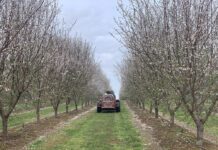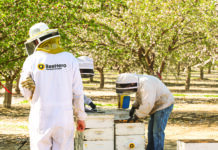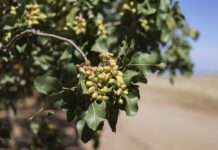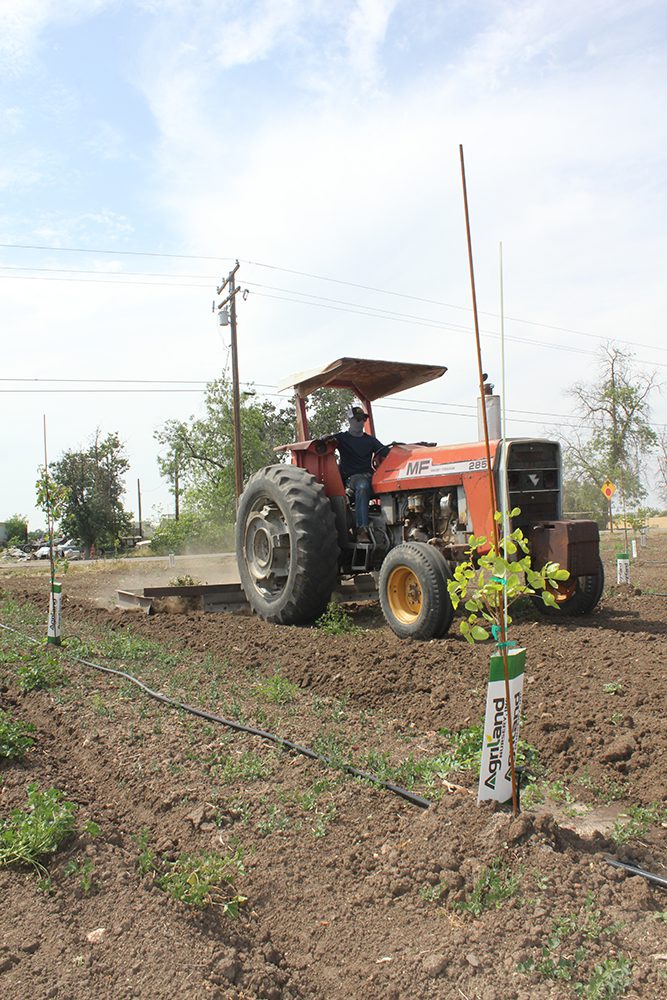
Selecting a new tree nut orchard site starts with soil suitability.
While location and water availability and quality are important aspects when selecting a new orchard site, soil quality can be a deciding factor and perhaps determine which tree species is the right fit. Potential sites with deep, uniform, loamy soils that have a combination of permeability and water retention can be ideal, but there are other soil properties to consider. Soil properties can affect nutrient uptake and plant growth.
A preplant soil sample to determine current nutrient levels of both macronutrients and micronutrients will dictate how much investment will be needed to add or if they can be skipped to prevent toxicities or deficiencies going forward. Finally, the previous crop at the site, row crop or tree crop, may have had an effect on the soil, and remediation may be necessary.
1. Soil Texture, Physical Barriers
Soil texture was identified by UCCE Soil Research Specialist Toby O’Geen as the top consideration for potential orchard site.
“You can’t change it, and it governs every other property of the soil,” O’Geen said. The percentage of sand, silt and clay in a soil is an indication of its productivity potential. Equal amounts of sand, silt and clay is ideal for food production as the soil will have excellent water holding capacity.
“If you can understand texture of the soil, you can understand behavior of the soil,” he said.
It is not just the top foot or so that is important. With trees, soil texture well below the root zone can have an effect on tree health and productivity. Compacted soils, hard pan, layers of sand or silt and rock fragments in the soil profile are all physical limitations that affect tree development and productivity during the span of the orchard life. Layers can change with depth, O’Geen said, and it is important to know their texture. Layers must be detected, evaluated and modified, if possible, prior to planting.
One way to determine presence of physical limitations at an orchard site is to dig a series of pits across the site to show the numbers and types of soil layers, their depth and variability. Decisions can then be made on feasibility of soil modification. Using deep tillage can break up man-made compact soil layers in the top 2 feet of the soil. This can improve water infiltration, soil aeration and root growth. Deep tillage can also be used to break through natural hard pan layers to improve drainage. It can also ease abrupt boundaries between different soil textures.
Sacramento Valley Walnut News reports if soil modification is necessary, it is best done prior to planting trees. Late summer or fall when the soil is dry is the preferred timing. Touch-up leveling can be done in the spring. Stratified soils or sites with hardpan layers will need deep ripping at 3 to 6 feet to disrupt layers.
Use of low-volume irrigation can help improve some soil physical characteristics.
2. Soil pH
Soil pH directly affects plant growth because it affects the availability of all plant nutrients. O’Geen said it is the most important chemical indicator of a soil’s ability to deliver nutrients.
UCCE Advisor Paul Vossen wrote most plant nutrients are in their most available state in soils with a pH of 6.0 to 6.5.
Soil acidity or alkalinity determines decomposition of mineral rock into essential elements for plant use. It also changes fertilizers from their applied form to a form that plants can access. Nitrogen, for example, is most available at neutral pH. Soil microorganisms depend on soil pH to change amino acids to the ammonium form of nitrogen to the nitrate form that plants can use.
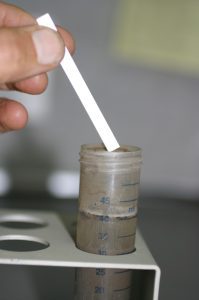
3. Organic Matter Content
Organic matter is only a small percentage of most soils by volume, but it plays an important role in soil health due to its interaction with other soil properties. Soil organic matter increases the water holding capacity of soil. It also increases cation exchange capacity and fertility. It supports microbial abundance and diversity.
Sustainable Agriculture Research and Education (SARE) program noted that most soils have 1% to 6% organic matter depending on biological and physical properties of the soil. Organic matter consists of living organisms, fresh residues and molecules from decomposed residues. The living organisms feed on the fresh residues and mix organic matter into the mineral soil.
Organic matter accumulates depending on rate of decomposition, which is driven by moisture, temperature and microbial composition. In water-limited environments, soils have less organic matter.
A visual indicator of organic matter accumulation is dark-colored surface soil.
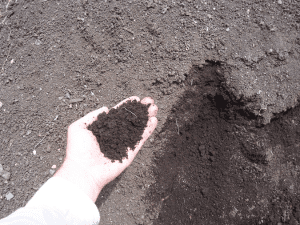
4. Cation Exchange Capacity (CEC)
A soil’s CEC indicates how much nutrient the soil can hold and how it should be irrigated. Justin Nay, crop consultant with Integral Ag, said CEC measures the soil’s ability to hold on to fertilizer and how difficult or easy it will be to correct deficiencies or toxicities.
Cation exchange capacity is measured in a laboratory by adding up all the cations present in a sample (Ca+Mg+K+Na+Al+H). Nay said heavy clay soils can have values from 30 to 40 in the Central Valley. Heavy sand soils have values from 3 to 10. Typical silty sand is 10 to 20 with overlap with silty clay at 15 to 25. The greater the CEC, the greater ability for the soil to hold fertilizer and water; a lower number represents the opposite.
Nay said a high CEC costs a lot of time and money to change if toxic elements are present or if the relative abundance of the cations is out of whack. Conversely low CEC values are relatively less costly and can be corrected.
“A simple CEC reading can tell you a lot about the level of investment a soil is going to require,” Nay said. The reading will also help provide fertigation and irrigation advice. That would be frequent short sets with low volumes of water for low CEC and longer sets with greater fertilizer less frequently in high-CEC soils, assuming they are in balance.
5. Previous Land Use Effects
The previous crop planted at a potential orchard site could have physical, chemical and biological impacts on the soil.
Tobias Oker, UCCE soils and irrigation advisor in Kern County, said the ways rows are planted, plant spacing, irrigation management and tillage practices affect the soil.
“If there is a lot of heavy traffic with equipment, there can be compaction issues. Shallow-rooted plants versus deep-rooted plants can make a difference in the soil,” Oker said.
SoilBasics Agronomist Jim White said cotton, corn and hay rotations at the potential orchard site can mean glyphosate residue in the soil, which ties up the micronutrient manganese which is used for respiration. This can cause water stress in newly planted trees. Soil microbiology and nutritional levels can also be affected by the residue in the soil.
White said he has also experienced tie-up of nitrogen and micronutrients in soils where an orchard is removed, chipped and the chips spread on the soil. It takes a while for the tannins in the wood to break down, White said, and ties up nutrients.
Some field crops also deplete soil nutrients. In fields where flood-irrigated alfalfa was grown, salts are pushed down 12 to 16 inches and can concentrate at that depth.
“It’s shallow roots versus deeper roots,” Oker said. The shift to permanent crops has to come, he said, with soil sampling and management of the soils where the tree roots will grow.

Cecilia Parsons | Associate Editor
Cecilia Parsons has lived in the Central Valley community of Ducor since 1976, covering agriculture for numerous agricultural publications over the years. She has found and nurtured many wonderful and helpful contacts in the ag community, including the UCCE advisors, allowing for news coverage that focuses on the basics of food production.
She is always on the search for new ag topics that can help growers and processors in the San Joaquin Valley improve their bottom line.
In her free time, Cecilia rides her horse, Holly in ranch versatility shows and raises registered Shetland sheep which she exhibits at county and state fairs during the summer.







